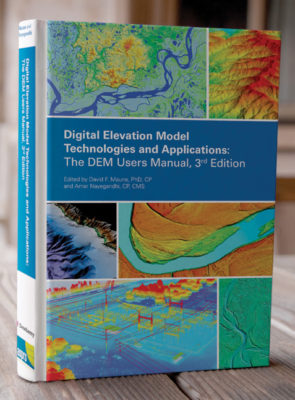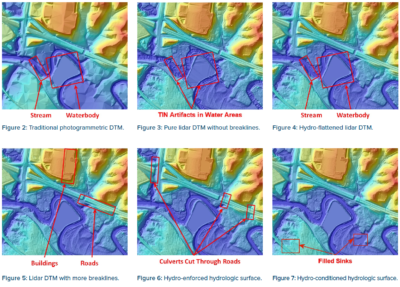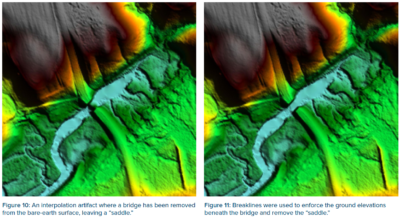When Digital Elevation Model Technologies and Applications: The DEM Users Manual, 2nd Edition was published in 2007, topographic lidar was a new and emerging technology that had produced data according to many different specifications and formats for a relatively small portion of America. Until recently, we lacked nationwide lidar standards, guidelines and specifications, and we had no nationwide program to deliver standardized lidar data of high accuracy/resolution.
Editor’s note: A PDF of this article as it appeared in the magazine is available HERE.
The long wait for the 3rd edition is over, and it was worth the wait. The 3rd edition (Figure 1) is now available in both hardcopy and e-book versions, and the co-editors (Dave Maune and Amar Nayegandhi) will be available at the ILMF/ASPRS/MAPPS conference in Denver in January 2019 to autograph copies with our signature “dream” for all DEM users—“May all your DEMs come true.” Whereas prices vary for ASPRS members or non-members, students will be able to purchase copies at minimal cost ($50) because Dewberry has borne all production and printing costs, with all sales proceeds going to ASPRS to support important professional development programs.
The 3rd edition includes 15 chapters and three appendices. References in the e-book version are hyperlinked for simple recovery. The chapters and appendices are:
- Introduction to DEMs
- Vertical Datums
- Standards, Guidelines and Specifications
- The National Elevation Dataset (NED)
- The 3D Elevation Program (3DEP)
- Photogrammetry
- IfSAR
- Airborne Topographic Lidar
- Lidar Data Processing
- Airborne Lidar Bathymetry
- Sonar
- Enabling Technologies
- DEM User Applications
- DEM User Requirements and Benefits
- Quality Assessment of Elevation Data
- Acronyms
- Definitions
- Sample Datasets
This book is your guide to 3-D elevation technologies, products, and applications. It will guide you through the inception and implementation of the U.S. Geological Survey’s (USGS) 3D Elevation Program (3DEP) to provide not just bare earth DEMs, but a full suite of 3-D elevation products using Quality Levels (QLs) that are standardized and consistent across the U.S. and territories. 3DEP is based on the National Enhanced Elevation Assessment (NEEA), which evaluated 602 different mission-critical requirements for and benefits from enhanced elevation data of various QLs for 34 Federal agencies, all 50 states (with local and Tribal input), and 13 non-governmental organizations. The NEEA documented the highest Return on Investment from QL2 lidar for the conterminous states, Hawaii and U.S. territories and QL5 IfSAR for Alaska. Chapters 1, 3, 5, 8, 9, 10, 13, 14 and 15 are “must read” chapters for lidar users and producers. For example, Chapter 1 (Introduction to DEMs), goes into great detail explaining the differences between hydro-conditioning, hydro-enforcement, and hydro-flattening and different forms of Digital Terrain Models (DTMs) (see Figures 2-7).
Chapter 3 (Standards, Guidelines and Specifications) introduces DEM users to the ASPRS Positional Accuracy Standards for Digital Geospatial Data v1.0, the ASPRS LAS Specification v1.4 and the USGS Lidar Base Specification v1.3 (2018), which are now standardized nationwide, as well as the National Ocean Service (NOS) Hydrographic Survey Specifications based on standards of the International Hydrographic Organization (IHO), which have now been adapted to bathymetric and topobathymetric lidar QLs.
Chapter 5 (The 3D Elevation Program) explains 3DEP, how it works, annual accomplishments to date, and USGS’s Broad Agency Announcement (BAA) process to acquire joint funding for lidar data produced to 3DEP standards. It also explains the U.S. Interagency Elevation Inventory (USIEI), which documents available lidar data.
Chapter 8 (Airborne Topographic Lidar) explains the basic concepts of topographic lidar scanning and sensors; compares traditional linear-mode lidar with photon-sensitive and Geiger-mode lidar; boresight calibration; and the status of current lidar sensor technologies from Teledyne Optech, Leica Geosystems, Riegl, and Harris.
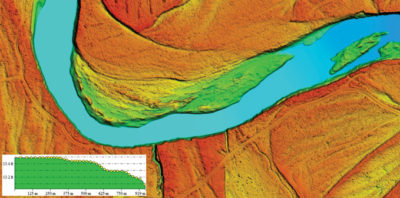
Figure 8: Example of a hydro-flattened river and profile of the downstream flow along the center of the feature. This river was flattened using a process where a centerline was collected and enforced for monotonicity and those elevations were applied to the stream banks.
Chapter 9 (Lidar Data Processing) explains concepts and approaches to automated filtering of lidar point clouds to include ground and non-ground points, noise, vegetation, structures and other above-ground features; manual editing of lidar; breakline processing to include area and linear hydrographic features (see Figure 8) and structures; DEM processing concepts and approaches, processing techniques, incorporating breaklines, DSM processing; and other derivative products including contours.
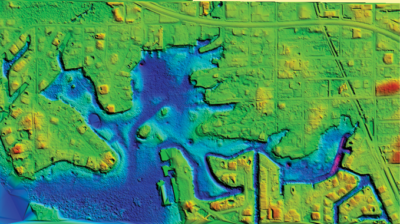
Figure 9: A topobathymetric DEM of King’s Bay, Florida, produced from the CZMIL sensor with maximum depths of 18 feet.
Chapter 10 (Airborne Lidar Bathymetry) explains the basic concepts of bathymetric lidar scanning and sensors; system design; data processing including system calibration; output formats and deliverables; and the status of current sensors including SHOALS, CZMIL, LADS, Chiroptera II/HawkEye III, EAARL, VQ 820/880-G, and Titan. An example of a CZMIL topobathymetric DEM is shown at Figure 9.
Chapter 13 (DEM User Applications) reviews how DEMs are vital for hundreds of user applications, all summarized in the NEEA’s 27 major DEM Business Uses that helped justify the 3DEP. These uses also help a state or local community justify funding for their own lidar acquisition programs.
Chapter 14 (DEM User Requirements and Benefits) explains why DEM users needing lidar data should normally state their requirements for standard QL2 lidar (except in Florida where QL1 is standard), consistent with the 3DEP so as to receive standard raw and classified point cloud data, standard breaklines, standard metadata, and standard hydro-flattened, bare-earth raster DEMs—all with potential common data upgrades that do not compromise standardization and interoperability.
Chapter 15 (Quality Assessment of Elevation Data) is a 90-page tutorial with images, designed to promote consistency in delivery of elevation data acceptable for the 3DEP. This chapter reviews relevant standards, guidelines and specifications; explains procedures for testing and reporting absolute and relative accuracy; and goes into great detail in addressing various forms of qualitative assessments, to include: source data QA/QC; breakline QA/QC (breakline completeness, variance and topology); macro level reviews of DEM data; and micro level reviews of topographic and topobathymetric DEMs including hydro-flattening or hydro-enforcement, edge-matching, and bare-earth editing of buildings, bridges and artifacts. This chapter also includes procedures for QA/QC of contours and metadata. Figure 10 shows an example of an interpolation artifact where a bridge has been removed from the bare-earth DTM, and Figure 11 shows the corrections to such artifacts necessary for 3DEP projects.
The remaining chapters are either relevant to all DEM technologies or address alternative technologies to lidar, including photogrammetry, IfSAR, and sonar.
Appendix A is a list of acronyms and Appendix B is a summary of definitions for technical terms used in the 3rd edition. Appendix C explains where to download sample elevation datasets.
